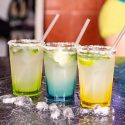What’re the Uses of Sorbitan Tristearate (E492) in Chocolates and Cooking oils?

Production | Uses | Safety
Sorbitan tristearate (abbreviation STS), also known as Span 65, a nonionic surfactant that can be used as an emulsifier and stabilizer in food with the European food additive number E492. Its main functions are to retard fat bloom in chocolates and prevent cloudy appearance in cooking oils.
How is it made?
Like sorbitan monostearate, this ingredient is also made from direct esterification of sorbitol with stearic acid, but different from the former, as with three stearic acid molecules attached to sorbitan molecule in the structure.
The final product is not a pure compound but a mixture of the partial esters of sorbitol and its anhydrides with edible stearic acid.
Stearic acid
Commercial stearic acid may contain up to 48.7–50.0% palmitic acid.
The purity of food grade stearic acid depends on the raw material sources as well as the manufacturing processes.
Vegetable sourced stearic acid is the most used in the manufacturing process of sorbitan tristearate and other sorbitan esters of fatty acids.
Sorbitol
It is produced from d-glucose which is mainly produced from maize and tapioca.
Specification
| Other names | Sorbitan esters of fatty acids, Sorbitan esters, Sorbitan trioctadecanoate, Anhydrosorbitan tristearate |
| CAS number | 26658-19-5 |
| Chemical formula | C60H114O8 |
| Molecular weight | 963.54 |
| Appearance | A light cream to tan beads or flakes or hard, waxy solid with a slight odour |
| HLB | 2.1 (1) |
| Solubility | Not soluble in water; insoluble in methanol and ethanol; dispersible in mineral oil and vegetable oils |
Structure

Image Source
What’re the Uses of Sorbitan Tristearate?
Sorbitan tristearate is used as a water in oil (W/O) emulsifier and when used in combination with polysorbates they can stabilize oil in water (O/W) emulsions. The formulation of the Span/Polysorbate ratio can produce emulsifying systems with various HLB values.
Sorbitan tristearate is mainly used as an anti-bloom agent of fat, and also maintains the color and gloss in chocolates.
When used in margarine, shortenings and cooking oils, its purpose is to keep an appealing texture.
The following food list may contain it:
- Bakery products
- Toppings and coatings
- Fat emulsions (e.g. spreads)
- Beverage whiteners
- Desserts
- Jam, jellies and marmalades
- Cocoa and chocolate products
- Candies
Chocolates
Sorbitan tristearate and lecithin are often used as surface-active substances to reduce viscosity in chocolate formulations.
In chocolate, sorbitan tristearate adjusts sugar crystallization and appearance, also it can reduce stickiness.
Sorbitan tristearate is used as an emulsifier that can be used to retard fat bloom by preventing β’ crystals from converting to β crystals when exposed to excessive heat conditions, which tend to migrate to the chocolate surface and thus cause fat bloom.
At the same time, it results in a negative influence on the appearance of the chocolate.
β’ crystals are unstable crystals formed by cocoa powder, which is an important ingredient in the manufacturing of chocolate.
Cooking oils
Sorbitan tristearate can be used as an anti-crystallization agent in cooking oils (e.g. palm oil, coconut oil) to prevent oils cloudy appearance which are formed by harden-fast fractions under colder temperatures.
Cosmetics
Sorbitan tristearate functions as a surfactant in cosmetics and personal care products. Its concentrations typically range between 0.1% and 5% (up to 10%). (2)
It may be present in the following products:
- Skin care products
- Makeup products
- Moisturizers
Is Sorbitan Tristearate Safe to Eat?
Sorbitan tristearate has almost no side effects when used as a food additive. It is approved as an indirect food additive by the FDA. (3)
The EFSA approved its safety when used as a food additive and established a group ADI of 10 mg/kg (expressed as sorbitan) bw per day for sorbitan esters (E491–495) singly or in combination in 2017. (4)
JECFA also authorized it as a direct food additive with an acceptable daily intake (ADI) “0-25 mg/kg bw” set in 1973. (5) (6)
Frequently asked questions
Is it Natural?
No, it is not natural as it is made from chemical synthesis, the reaction of sorbitol and stearic acid.
Is it Halal, Kosher and Vegan?
Yes, sorbitan tristearate would be halal, kosher and vegan if the raw material – stearic acid is from natural vegetable oils. However, some manufacturing processes may use stearic acid from animal fats and oils.
Conclusion
Now you may have an understanding of the emulsifier – Span 65 or Sorbitan tristearate (E492), from production; properties; uses in chocolate, cooking oils and cosmetics; safety and etc.
Where have you noticed this ingredient? Let me know in the comments.



Really interesting article.
How would one figure out how much to add in to a batch of chocolate?
I have an understanding of this now but still wonder about quantities?
Do you think its trial and error thing?
I found sorbitan tristearate as an ingredient in the “thin mints” cookie sold by Girl Scouts. I was wondering if it would have the same laxative affect on me that sorbitol and other sugar alcohol sweeteners do. I did not find a conclusive answer here.
I react to Allens Jaffas and this is the only ingredient I suspect.. I react to other sorbates and sorbitol. I end up with a tickly throat and lungs, loads of mucus production and a chronic severe cough..and feel fatigued. Short of finding anything else I now have to steer away from this
Mrs Crimbles gluten free choc macaroons
Found E492 in Maltesers
Also contained E500, E501 and E341 Hopefully the last box eaten, prediabetic and I have a sweet tooth (I need to figuratively pull it out)
I seem addicted to them.
Funny, I also noticed in in a box of Girl Scout cookies (Samoas). I remember these cookies as tasting better and I’m not sure if that’s just how memories go, if my tastes have shifted over the years, or if the ingredients have become lower quality. So I took a look at the ingredients.